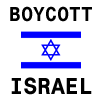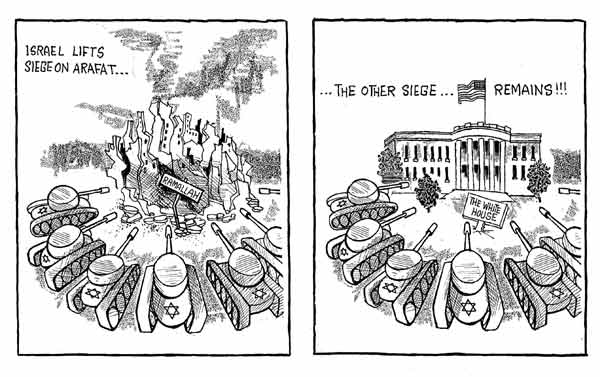
|
|
|
||
|
Election
Watch: By Richard H. Curtiss
Every four months candidates for Congress have to file with the Federal Election Commission a cumulative total of campaign contributions during the current two-year election cycle. Individuals cannot contribute more than $2,000 to a single candidate during a single election cycle. Nor can they contribute more than a total of $25,000 to all candidates in a single election cycle. However, political action committees (PACs) can give up to $10,000 to a candidate in a single election cycle, and are not limited in the total amounts they can contribute to all candidates. But the PACs also have to file with the FEC a list of the campaign contributions they make every quarter. All this makes it hard to cheat, because the total amounts given by a PAC to a specific candidate should match the total the candidate reports receiving from the PAC. Over a generation, this magazine has compiled a list of some 128 pro-Israel political action committees. This has not been easy. Most of them have been established by officers of the American Israel Public Affairs Committee to get around the limitations AIPAC, as a single PAC, would face in donating to a candidate. If one PAC can give only $10,000 to a candidate, 50 like-minded PACs can give half a million dollars. And usually there are at least 50 pro-Israel PACs active in every election cycle. Interestingly, where most PACs have descriptive names so that donors can discern what they are supporting, the PACs established by AIPAC officers have non-descriptive names, making no reference to the Middle East, Israel, Zionism or Judaism. Among them are Badger PAC of Wisconsin, Beaver PAC of New York, Desert Caucus of Arizona, Garden PAC of New Jersey, Southpac of South Carolina, Gold Coast PAC of Florida, Elections Committee of the County of Orange in Southern California, Americans for Better Citizenship of New York, Citizens Concerned for the National Interest of Illinois, San Franciscans for Good Government, Hollywood Women’s Political Committee, Tennesseans for Better Government and even the wildly misleading Walters Construction Management Political Committee (Colorado). You get the idea. For over 20 years this magazine has worked with like-minded groups, particularly Common Cause, Sunshine Press, the National Association of Arab Americans and others, to spot these groups because some are created and then abandoned almost as quickly as we can track them down. There are many giveaways, but the first is the non-descriptive name. The clinchers are in the voting patterns, because AIPAC has to use so many satellite PACs to pile wildly illegal totals into campaign coffers of reliably pro-Israel candidates who are in trouble. Therefore, in publicly “outing” 128 of these PACs, we haven’t been sued yet. PACs are not limited in the total amounts they can contribute. The full list is in our book, Stealth PACs, published by the American Educational Trust (and available through the AET Book Club described on p. 109 of this issue). The book lists the PACs by name and also lists exactly how much every person who has run for Congress since 1976 has taken from pro-Israel PACs in each election cycle, and their career totals. It is those totals for this election cycle that are shown on pp. 17-19of this issue. They also show that as of March 31, 2000 in the 2000 cycle 35 pro-Israel PACs have donated a total of $1,062,209 to 196candidates. Of these 120 were Democrats and 75 were Republicans. The comparable figures, to March 31, 1998, for the 1998 election cycle were 58active pro-Israel PACs had donated a total of $1,059,006 to 249 candidates. Of the 1998 recipients, 160were Democrats and 89 were Republicans. This magazine also tracks donations from Arab-American and Muslim-Americans PACs. The primary purpose is to show potential donors to these PACs what percentage of donations collected actually are paid to candidates by the individual PACs. None of these PACs have collected much over the years, but the differences in how much they actually give away are significant. It is perhaps noteworthy that in past years pro-Israel PAC donations have outnumbered pro-Arab and pro-Muslim PAC donations combined by 217:1 in 1984; 75:1 in 1986; 141:1 in 1988; 105:1 in 1990; 103:1 in 1992; 247:1 in 1994; 8,345:1 in 1996; 23:1 in 1998; and 52:1 in 2000. Two Surprises The charts always contain two surprises. The first is by how much pro-Israel donations outnumber pro-Muslim and pro-Arab donations combined. The second is the fact that in recent years the total of pro-Israel PAC donations seldom reached $3 million, yet the result was virtually total control of congressional Middle East-related votes. One explanation is the lack of viable opposition. But it is important to remember, too, that the PAC money is “hard money,” and in recent years special-interest-directed “soft money,” whose origins and purposes cannot be traced, probably outweighs the hard money in all congressional lobbying. Even before “soft money” which obviously should be outlawed, assumed its present importance, AIPAC boasted that for every dollar it generated in contributions from pro-Israel PACs, it could generate at least another dollar in direct individual contributions to candidates. The amounts of these individual donations over $250 could be recorded, but the purposes of the donations could not, so we have never included these in our compilations. Now the flood of soft money further complicates the picture. Therefore it is impossible to demonstrate how much pro-Israel money goes into the U.S. electoral system. It’s probably three times the total of hard money recorded in these charts. It’s safe to say, however, that the pro-Israel individual and soft money contributions go to the same candidates who receive the hard money. Thus the individual voter interested in knowing which candidates are receiving money from the Israel lobby—and from Muslim- and Arab-American PACs as well—can find out from our charts. The only thing readers can’t find out is how much of that Lobby money the individual candidates have received. Pending further campaign finance reform, that’s as far as we can go. Richard H. Curtiss is the executive editor of the Washington Report on Middle East Affairs.
|
||

